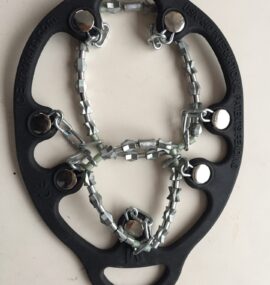Sit at home?
Find a Way to Keep Moving?
A mountain of evidence supports the proposition that Keep Moving promotes better health and well-being. Yet, sometimes events conspire to put barriers, real or imagined, in our path. For example, cold weather, snow, and ice. As I write this post, snow is falling in 21 degree air in Boulder, Colorado. The weather forecast calls for one inch of snow accumulation but two inches already cover the ground. What can a health-minded person do in this situation besides plopping down in the easy chair and complaining?
How about taking a walk? This isn’t as silly or ill-advised as it might seem. Traction aids can make all the difference between sitting around inside and walking safely and comfortably outside. Traction devices can be especially useful for balance- or vision-impaired older people who are reluctant to venture outside during snowy weather. Several manufacturers make traction aids that allow you to walk safely under snowy or icy conditions.
Right now in Boulder, the cold air and fresh snow provide fine foot traction. During my after-lunch walk, my low-cut Merrell Moab 2 Ventilator hiking shoes with a lug-type sole worked great. I didn’t slip even slightly plus my feet stayed warm. Generally speaking, freshly fallen, unpacked snow provides acceptable traction, especially when the air is cold.
However, after cars or people pack the snow, particularly as the air warms and after the sun comes out, traction can drop to near zero. A thin layer of snow over ice is especially treacherous! Under these conditions, you need reliable foot traction to avoid slipping and falling.
What do you look for in traction aids that allow you to negotiate safely and confidently hard-packed snow and ice? Generally, you want some type of studded metal or steel chain links or cleats that will grip packed snow and ice. I don’t recommend long spikes for around-town use, because you’ll probably encounter patches of thin or non-existent snow or ice. You might damage long spikes when you walk on bare pavement. You want a traction aid that’s durable and won’t fall apart when you walk on short sections of concrete. Finally, you want a snug (but not overly tight) fit on the shoes you customarily wear under snowy conditions. You don’t want the traction aid to slip around as you walk. But you want to be able to put it on and take it off easily, otherwise you probably won’t use it.
You might check the Recreational Equipment, Inc. website to see what’s available. Searching on “winter traction devices” on the REI website returned 20 items. Then head down to your local outdoor store to inspect and try on several pairs to make sure they fit. The photo that accompanies this post shows one (of a pair) of my wife, Betsy’s, ICETrekkers. They work great on compacted snow and ice, plus they work well on short stretches of pavement. ICETrekkers provide plenty of traction (without overdoing it) at a reasonable cost.
If you live in a snowy climate and avoid going for walks when the snow falls, do yourself (or your significant other) a favor and buy a pair of traction aids. And Keep Moving!




